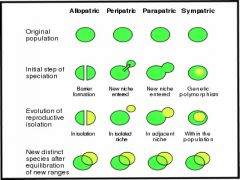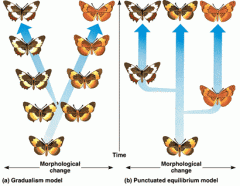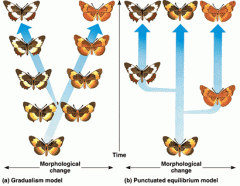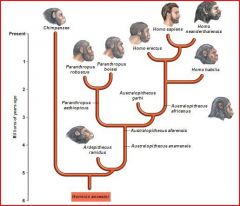![]()
![]()
![]()
Use LEFT and RIGHT arrow keys to navigate between flashcards;
Use UP and DOWN arrow keys to flip the card;
H to show hint;
A reads text to speech;
23 Cards in this Set
- Front
- Back
|
Systematics & the Diversity of Life |
Classification of organism based on evolutionary history(?) |
|
|
Evolution |
Change in gene frequency in a population |
|
|
Gene frequency |
Number of organisms having the genes for particular traits |
|
|
Species |
-Group of reproductively isolated organisms - Organisms that cannot interbreed with other species |
|
|
But with technology, it is now possible to manipulate the sperm and the egg, from different species, to produce an offspring |
This does not hold true for asexual organisms |
|
|
Reproductive Isolation |
1. Egg and sperm don't mature at the same time 2. Species found in a geographical area far from the position of the other sex |
|
|
Scientific name |
genus + species |
|
|
Mechanisms of Evolution |
1. Genetic Drift 2. Gene flow 3. Natural Selction |
|
|
Genetic Drift
|
Genetic drift takes place when the occurrence of variant forms of a gene, called alleles, increases and decreases by chance over time
- when they die |
|
|
Gene flow |
gene flow (also known as gene migration) is the transfer of alleles or genes from one population to another. Migration into or out of a population may be responsible for a marked change in allele frequencies (the proportion of members carrying a particular variant of a gene). |
|
|
Natural Selction |
the process whereby organisms better adapted to their environment tend to survive and produce more offspring -elimination of the unfit -survival of the fittest |
|
|
Evidence of Evolution |
1. Biogeography 2. Comparative embryology 3. Fossil Record 4. Molecular Biology 5. Comparative Anatomy |
|
|
Historical Context: Lamarck: Use and Disuse |
states that when certain organs become specially developed as a result of some environmental need |
|
|
Natural Selection (2) |
1. Common Ancestor 2. Due to Limited Resources organisms undergo competition 3. NS sees to it that the fittest survive, and the unfit are eliminated 4.Descent with Modification 5. Selection and Adaptation |
|
|
Evo-devo (Evolutionary -developmental biology) |
-There has been evolution in the developmental stages of organisms -If 1 organism mutates, no evolution -If many organisms mutate, there is evolution |
|
|
Modes of Speciation |
1. Allopatric Speciation 2. Sympatric Speciation |
|
|
Allopatric Speciation |

occurs when biological populations of the same species become vicariant, or isolated from each other to an extent that prevents or interferes with genetic interchange.
|
|
|
Sympatric Speciation |

the process through which new species evolve from a single ancestral species while inhabiting the same geographic region
|
|
|
Gradualism |

theorizes that most speciation is slow, uniform and gradual. When evolution occurs in this mode, it is usually by the steady transformation of a whole species into a new one (through a process called anagenesis).
|
|
|
Punctualism |

evolution occurs in spurts of relatively rapid change with long periods of non-change
|
|
|
Evolutionary Radiation of the Eukaryote Evolutionary relationships of the 6 kingdoms Animal Ancestral Tree
Evolutionary History of Vertebrates Timeline of terrestrial vertebrate evolution |
could not have happened without evo-devo |
|
|
Human Evolution |

3 major... 1. Homo habilis 2. Homo erectus 3. Homo sapiens |
|
|
Evolution of Sex |
female-type first |

